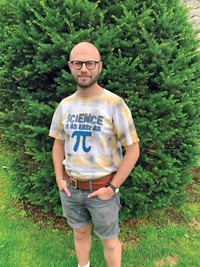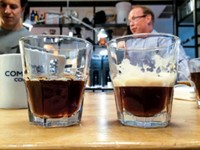Advertisement
Grab your lab coat. Let's get started
Welcome!
Welcome!
Create an account below to get 6 C&EN articles per month, receive newsletters and more - all free.
It seems this is your first time logging in online. Please enter the following information to continue.
As an ACS member you automatically get access to this site. All we need is few more details to create your reading experience.
Not you? Sign in with a different account.
Not you? Sign in with a different account.
ERROR 1
ERROR 1
ERROR 2
ERROR 2
ERROR 2
ERROR 2
ERROR 2
Password and Confirm password must match.
If you have an ACS member number, please enter it here so we can link this account to your membership. (optional)
ERROR 2
ACS values your privacy. By submitting your information, you are gaining access to C&EN and subscribing to our weekly newsletter. We use the information you provide to make your reading experience better, and we will never sell your data to third party members.
Education
Newscripts
Cake In A Can, Color-Changing Ice Cream
by Bethany Halford
September 1, 2014
| A version of this story appeared in
Volume 92, Issue 35

The Newscripts gang has seen the future of food, and it is sweet. For everyone who loves freshly baked cake but hates the time it takes to mix the ingredients and wait for the batter to rise in the oven, there is now an alternative. Two Harvard University undergraduates have come up with Spray Cake—cake batter that’s squirted from a can.
A little more than a year ago, John McCallum was trying to come up with a final project for his “Science & Cooking” class. Joanne Chang, a chef at Boston’s Flour Bakery, had talked to the class earlier in the semester about the chemistry that makes cakes rise. McCallum tells the Boston Globe that he was in the lab racking his brain for final project ideas, when off in the distance he saw someone spraying whipped cream from a can and the memory of Chang’s lesson returned to him. Was it possible, he wondered, to deliver cake batter in the same way?
When whipped cream is dispensed from a can, gas bubbles are released into the cream to give it its frothy texture. McCallum figured that the same process could deliver bubbles into cake batter, eliminating the need for the baking soda and baking powder, which make cakes rise.
His friend and fellow student Brooke Nowakowski thought McCallum was onto something. Together the two perfected their recipe in a dormitory kitchen and then founded the start-up Spray Cake.
The beauty of Spray Cake is that because the batter is infused with bubbles, there’s no need to wait for the confection to rise. A cupcake can be cooked in a microwave in 30 seconds. Baking in a traditional oven is also faster for Spray Cake than it is for batters from mixes or from scratch.
And Spray Cake isn’t just for the impatient. Nowakowski tells the Boston Globe that it’s a good way to control portions: “You can simply pull it off the shelf, make one cupcake, then put it back in the fridge and it won’t go bad.”
With the $10,000 award they won from the 2014 Harvard College Innovation Challenge, McCallum and Nowakowski hope getting their product on store shelves will be a piece of cake.
For the perfect accompaniment to futuristic cake, the Newscripts gang would like to suggest a scoop of ice cream that changes color when you lick it.

The new color-shifting concoction was dreamed up by physicist turned ice cream entrepreneur Manuel Linares. Linares calls the fruit-flavored delicacy Xamaleón, a play on the Spanish word for chameleon.
Xamaleón starts out with a periwinkle-blue hue. Once it’s scooped into a cone or cup, a server spritzes the ice cream with what Linares calls “love elixir.” The mixture then reacts to changes in temperature and chemicals in saliva to turn purple and then pink as it’s licked.
Linares has kept the chemicals that give the ice cream its color-changing properties a secret. So far he’s revealed only that the recipe is all natural. At the moment, folks wanting to sample Xamaleón will need to visit IceXperience, Linares’s ice cream shop in Spain. Now that sounds like a cool idea for a trip.
Bethany Halford wrote this week’s column. Please send comments and suggestions to newscripts@acs.org.





Join the conversation
Contact the reporter
Submit a Letter to the Editor for publication
Engage with us on Twitter